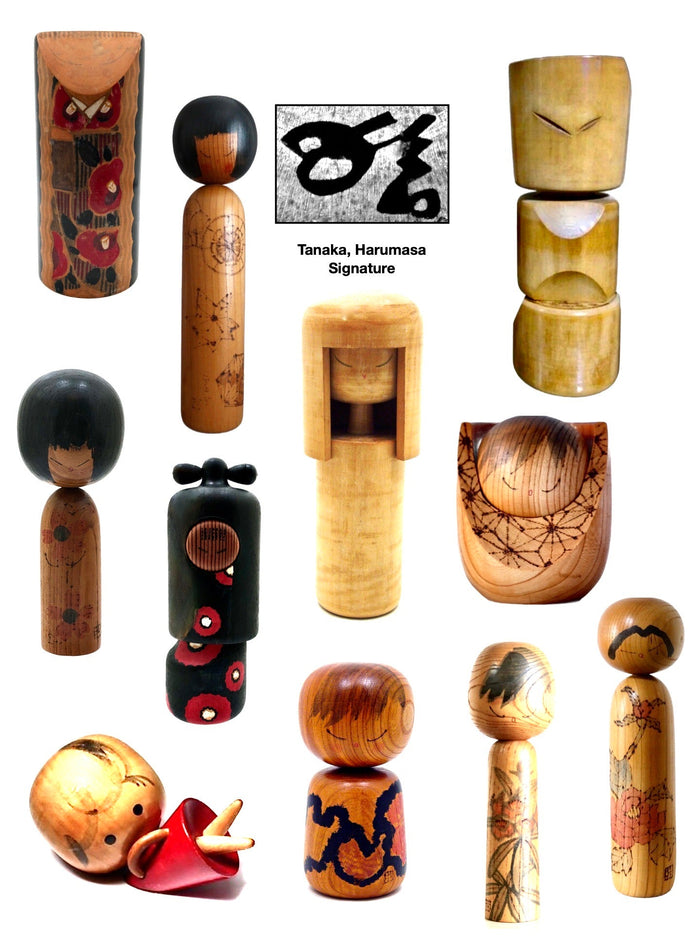

Vintage Sosaku Kokeshi entitled: “Kantsubaki | Winter Camellia” by Tanaka, Harumasa
Dimensions: 7-1/4”h
This is a 1965 award-winning doll and a very rare, possibly one-off creation since no others have been recorded or placed on the market. It is one of the only abstract and artistically executed Sosaku Kokeshi that has won numerous awards at the 12th Annual All-Nippon Japan Kokeshi Competition.
One must look closely to see that the slanted portion of the face incorporates a face with eyes humbly casting downward, and a suggestion of bangs running across the top of the head, contrasting to the abstractness of the red Camellia used to define the front of the Kimono. Other than the elaborately painted front portion, (scallop-edged head and body form), of this doll, the un-ornamented portions of the figure are finished in black lacquer and focused on all the beautiful work on the front of the doll. There is an old type of circular detailed inscription in Kanji and a script signature identifying the artist on the bottom of the doll.
The piece was published in Sosaku Kokeshi: Celebrating the Major Artists of the Creative Movement in 2022. For more information on this artist go to the following link: https://mingeiarts.com/collections/artisan-woodworker-tanaka-harumasa.
Condition: Excellent meaning that the piece retains its original craft/workmanship showing a wonderfully developed patina commensurate with age which suggests a degree of wear that corresponds to its vintage and is void of damage, cracks, breakage, or repairs. This doll meets all the standards of the collectible Japanese Sosaku Kokeshi by Tanaka, Harumasa.

Artisan
Woodworker: Tanaka, Harumasa
Biographical History:
Tanaka-san is acknowledged as a leading member of the Sosaku movement in the 1950s-60s and is a multiple award winner. His doll “Dojo”, (Young Lady), won the Prime Minister’s Award in 1965 at the 12th Annual All Nippon Japan Kokeshi Competition. He additionally was recognized with his creation entitled: Kantsubaki, (Winter Camellia). There is little biographical data on Tanaka-san, but as researchers and collectors, we felt it was most important to represent all Sosaku Kokeshi artists, and whether or not the artist has a written account of his or her life. No dates of Tanaka-san birth or death have been recorded.
Collector's note – descriptive qualities, standard characteristics & ornamentation styles:
Tanaka beautifully illustrates the accomplished use of form, un-ornamented, and exceptionally painted surfaces. The artist uses wood to express feelings, related to the abstract treatment of the body. Modern-thinking young girls loved these abstract flamboyant designs in their garments to show that they had moved into a contemporary world which transformed their lives and connected them to the West. The most unusual aspect of course is the hair design style and ornaments, which is uniform and adds elegance to his interpretation of the figure. His abstract motifs are typically flowers, i.e., poppies and camellia in bold-colored lacquer. His most famous is the Kokeshi entitled: “Dojo or Young Lady”, left unadorned and relies solely on the carved form. The upswing eyes are extremely expressive with a simple red dot to express the nose and the hair treatment of this award-winning doll was always a uniform ‘Bob’ hairstyle. Dolls from this series were only made from Birch wood.
Several of his Kokeshi were published and cited as a Japanese competition winner introduced in the United States under the auspices of the Japan Society of New York. The exhibition was hosted by JETRO (Japan External Trade Organization). The catalog entitled: Kokeshi Dolls From Japan,(Printed by DOBI Printing Co., Ltd. Japan), citing 232 Kokeshi, for which the image of his works were featured with the artist/designer, name of the doll, (English and Japanese), and the size of the doll.
Explore & Learn More about Woodworker: Tanaka, Harumasa